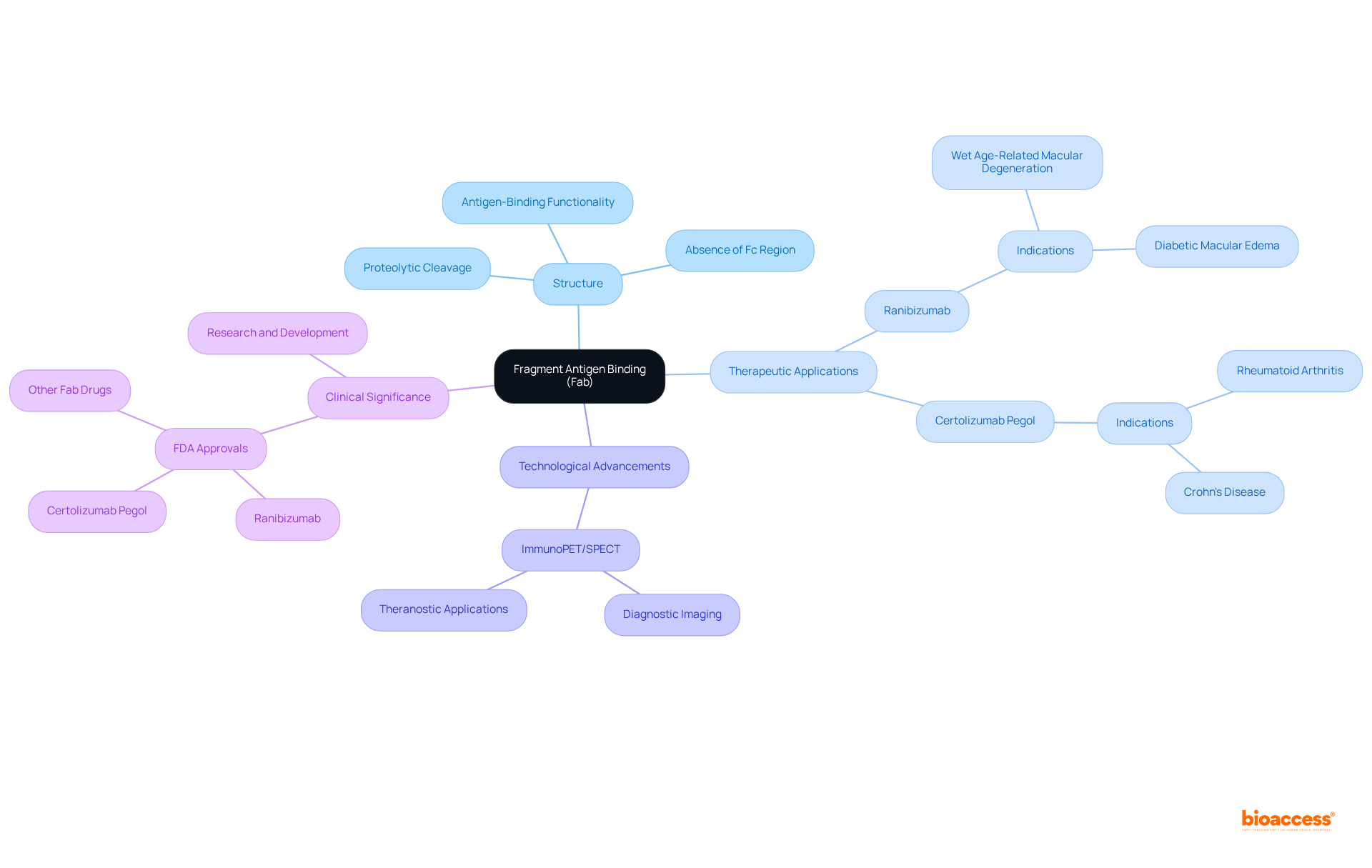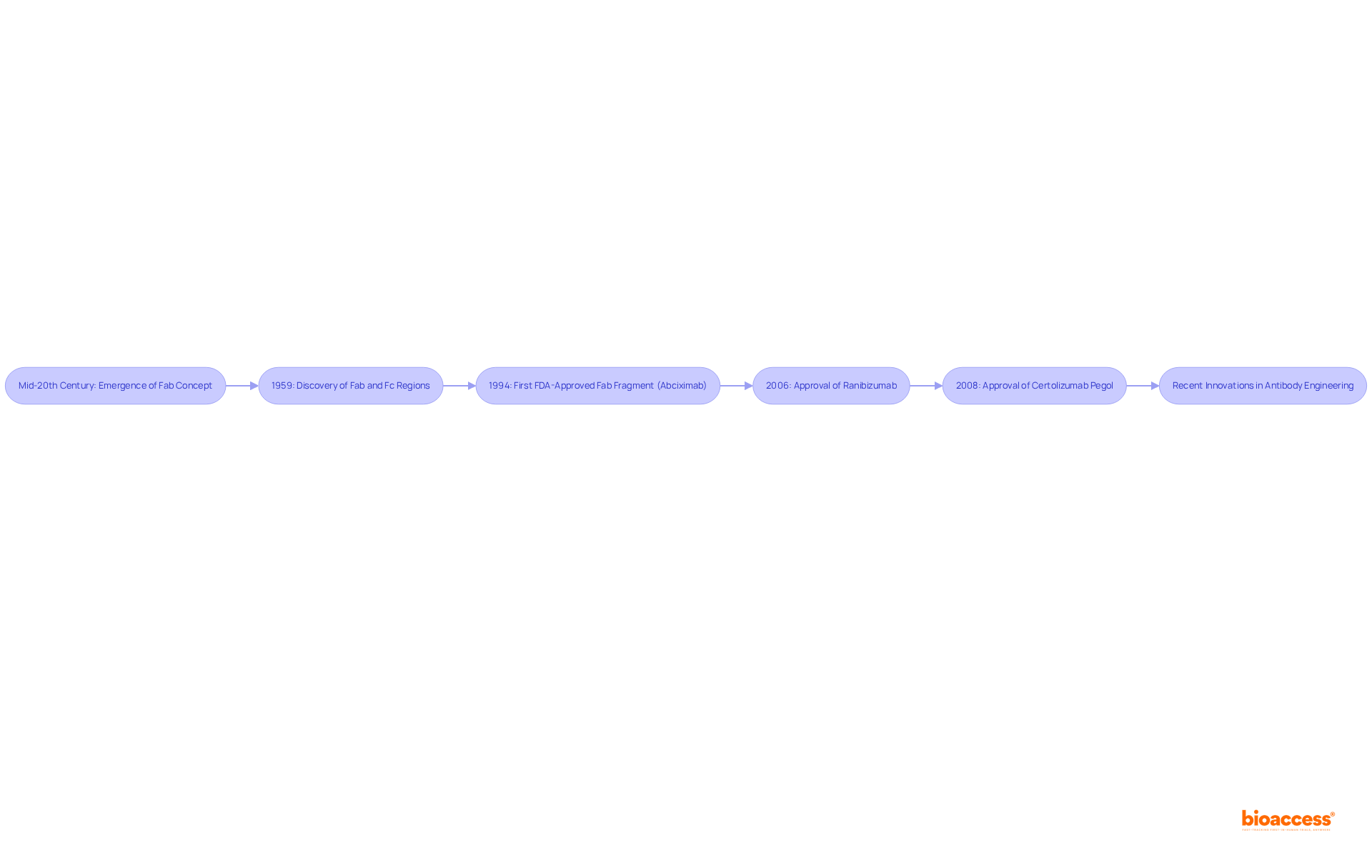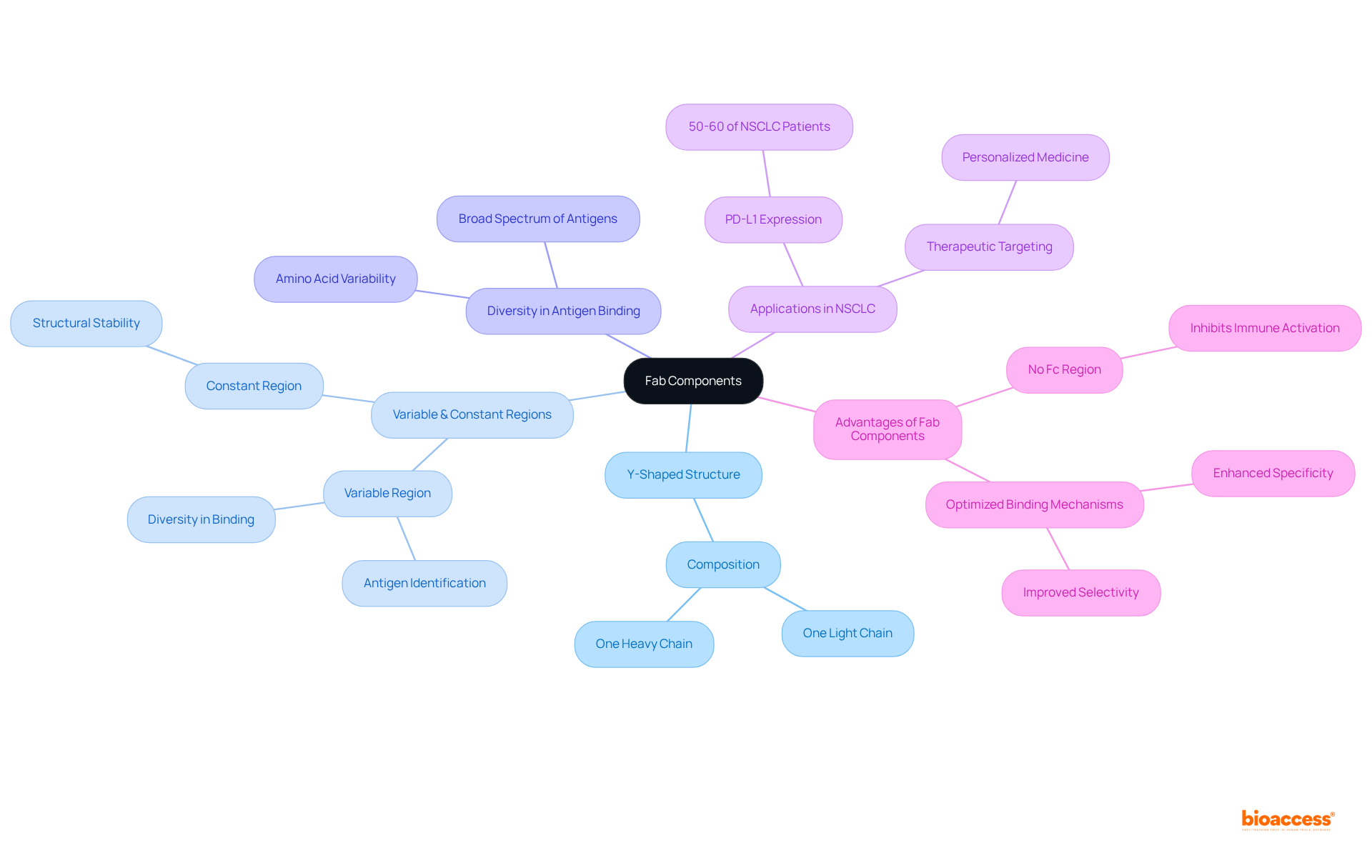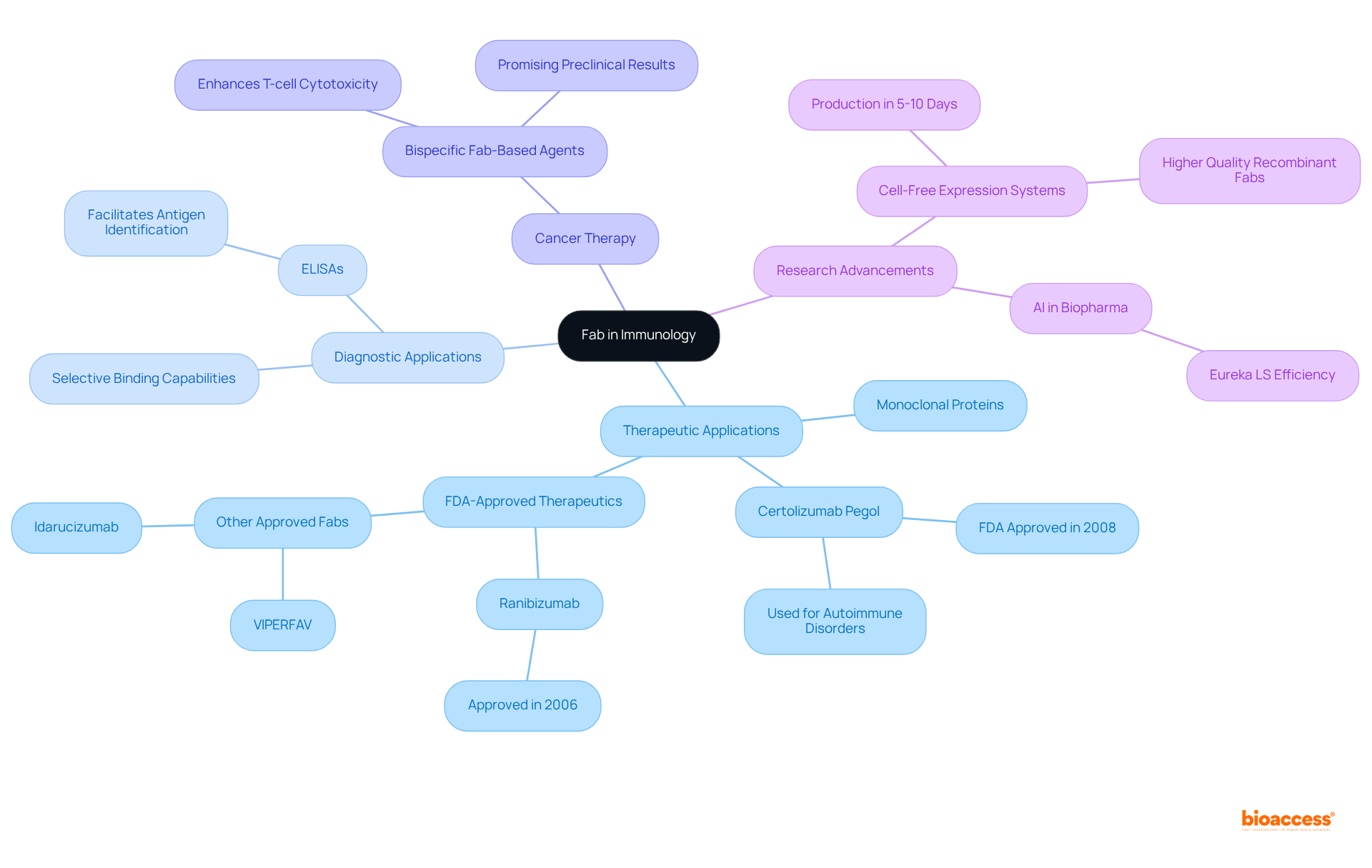


Fragment antigen binding (Fab) is the portion of an immunoglobulin that is crucial for binding to specific antigens, thereby playing a vital role in the immune response and therapeutic applications. This article delineates the historical development, structural characteristics, and significant clinical applications of Fab. It highlights its evolution from fundamental research to becoming essential components in targeted therapies and diagnostic tools, including bispecific antibodies and enzyme-linked immunosorbent assays (ELISAs). Understanding Fab's contributions not only underscores its importance in immunology but also emphasizes its transformative impact on clinical research and therapeutic innovation.
Fragment antigen binding (Fab) is crucial in the immune system, acting as the frontline defense against pathogens by recognizing and binding to specific antigens. This distinctive capability not only enhances targeted immune responses but also paves the way for innovative therapeutic applications, including monoclonal antibodies and advanced drug delivery systems.
As the field of immunology progresses, a significant question emerges: how can the ongoing development of Fab technology tackle complex medical challenges while minimizing potential side effects?
An exploration of the history, structure, and diverse applications of Fab components reveals their transformative impact on both diagnostics and therapeutics in contemporary medicine.
Fragment antigen binding (Fab) is a critical area of an immunoglobulin that is responsible for binding to antigens, playing an essential role in the immune response. This binding capability enables immune proteins to recognize and connect with specific pathogens or foreign substances, facilitating targeted immune action.
Structurally, Fab segments are produced through the proteolytic cleavage of immunoglobulins, resulting in two identical pieces that preserve antigen-binding functionality while lacking the Fc region, which mediates effector functions. This distinct arrangement not only enhances the therapeutic potential of fragment antigen binding but also reduces immunogenicity, making these components particularly valuable in various clinical applications.
Recent advancements in fragment antigen binding technology have led to the development of innovative therapeutic agents, including bispecific immunoglobulins and antibody-drug conjugates (ADCs), which leverage the specificity of fragment antigen binding portions to deliver cytotoxic agents directly to tumor cells. For instance, the FDA has approved several Fab fragment-based drugs, such as ranibizumab for treating wet age-related macular degeneration and certolizumab pegol for autoimmune diseases. As of April 2025, at least eight Fab antibody drugs have been approved globally, underscoring their clinical significance.
Moreover, ongoing research continues to explore the role of Fab portions in enhancing diagnostic imaging techniques, particularly in immunoPET/SPECT applications. These advancements are poised to improve patient management by providing more precise imaging capabilities, thereby facilitating better treatment decisions. As the field progresses, the significance of Fab components in both therapeutic and diagnostic contexts remains a central aspect of innovation in immunology.

The concept of fragment antigen binding (Fab) emerged in the mid-20th century, following the groundbreaking discovery of immune proteins and their vital role in the immune system. A significant milestone occurred in 1959 when researchers demonstrated that immune proteins could be divided into distinct sections, which included the identification of the fragment antigen binding (Fab) and Fc regions. This foundational discovery spurred extensive investigation into the structure and function of antibodies, paving the way for future innovations.
Over the years, advancements in molecular biology and biotechnology have revolutionized the production of recombinant Fab units, utilizing fragment antigen binding to significantly enhance their therapeutic applications. For example, the first FDA-approved fragment antigen binding Fab fragment, abciximab, was introduced in 1994, marking a crucial turning point in the clinical utilization of these components. Subsequent approvals, such as ranibizumab in 2006 and certolizumab pegol in 2008, further solidified the role of fragment antigen binding in targeted therapies.
Expert insights underscore that the evolution of therapeutic agents is reflected in the development of fragment antigen binding components, highlighting a broader trend in immunology towards more specific and effective treatments. The integration of new technologies, including single-chain variable fragments (scFvs) and bispecific proteins, underscores the ongoing progress in this field.
A timeline of key discoveries illustrates the advancements made since the initial recognition of Fab components. From the pioneering studies in the 1960s to the recent breakthroughs in antibody engineering, the journey of fragment antigen binding units showcases their transformation from fundamental research tools to indispensable elements in contemporary therapeutic strategies. This evolution not only emphasizes the importance of fragment antigen binding components in immunology but also highlights their potential to address complex medical challenges through targeted interventions.

Fab components are characterized by a unique Y-shaped structure, comprising one light chain and one heavy chain, which is crucial for antigen binding. Each component features a variable region dedicated to the identification of specific antigens, alongside a constant section that ensures structural stability. The diversity of Fab regions is derived from the variability in the amino acid sequences of these variable areas, enabling them to bind to a broad spectrum of antigens. Notably, approximately 50%-60% of patients with non-small cell lung cancer (NSCLC) express PD-L1, underscoring the importance of Fab components in targeting specific biomarkers for therapeutic applications. The absence of the Fc region in Fab portions inhibits the activation of immune effector functions, making them particularly suitable for therapies that require precise binding without eliciting an immune response. Recent research indicates that the binding mechanisms of Fab components can be optimized to enhance specificity and selectivity, thereby advancing their application in personalized medicine. Experts in the field emphasize that the modular characteristics of immune proteins facilitate the development of personalized treatments, with Fab sections playing a pivotal role in this evolution.

Fab portions play a crucial role in immunology, especially in the context of fragment antigen binding, which is vital for the development of diagnostic instruments and therapeutic agents. The use of fragment antigen binding in creating monoclonal proteins has revolutionized the treatment landscape for various diseases, including cancer and autoimmune disorders. A notable example is the FDA-approved certolizumab pegol, a PEGylated Fab portion, which has demonstrated significant efficacy in managing conditions such as rheumatoid arthritis and Crohn's disease. This underscores the medical potential of Fab portions in clinical settings. Moreover, the pipeline for fragment antigen binding (Fab) antibody therapeutics includes eight FDA-approved therapeutic Fabs, highlighting their importance in clinical applications.
In the realm of cancer therapy, fragment antigen binding portions are increasingly recognized for their ability to enhance targeted treatments. Recent advancements in bispecific Fab-based agents have yielded promising results in preclinical studies, where they engage two distinct antigen-binding sites. This dual engagement improves T-cell mediated cytotoxicity and tumor lysis in refractory cancers, highlighting the growing significance of fragment antigen binding in developing effective cancer therapies.
Furthermore, diagnostic tests, such as enzyme-linked immunosorbent assays (ELISAs), utilize fragment antigen binding portions, which facilitate the identification of specific antigens in biological samples. Their selective binding capabilities enable precise diagnostics while minimizing non-specific immune responses, rendering them invaluable in clinical diagnostics. Notably, Fab antibodies do not trigger antibody-dependent cellular cytotoxicity (ADCC) or complement-dependent cytotoxicity (CDC), which can be advantageous in specific treatment scenarios.
As research progresses, the significance of fragment antigen binding components in advancing immunological understanding and enhancing patient outcomes continues to grow, underscoring their vital role in both therapeutic and diagnostic applications. As Yannick Kronimus articulated, "On one side, recognition and neutralization of antigens is facilitated by the Fab part, and on the other side, processes such as phagocytosis, complement activation, and inflammatory reactions are initiated by the Fc portion." This statement highlights the dual functionality of Fab portions in immunology. Additionally, the efficiency of Fab fragment production is noteworthy, with cell-free expression systems enabling production timelines of just 5-10 days, which accelerates advancements in clinical research.

Fragment antigen binding (Fab) serves as a pivotal component in immunology, essential for the targeted binding of antigens and the development of advanced therapeutic agents. Its unique structure and functionality have transformed the landscape of medical treatments, enabling more precise interventions across various diseases, particularly in oncology and autoimmune disorders.
This article has explored key aspects of Fab, including its historical development, structural characteristics, and significant applications in both therapeutics and diagnostics. The evolution from basic research to the approval of multiple Fab-based drugs illustrates the increasing importance of these components in clinical practice. Innovations such as bispecific agents and enhanced imaging techniques further underscore the versatility and potential of Fab fragments in improving patient outcomes.
The ongoing advancements in fragment antigen binding technology highlight its significance in addressing complex medical challenges. As research continues to evolve, the potential for Fab components to enhance personalized medicine and targeted therapies remains promising. Embracing these innovations is essential for advancing immunological understanding and improving treatment strategies in the future.
What is Fragment Antigen Binding (Fab)?
Fragment antigen binding (Fab) is a part of an immunoglobulin that binds to antigens, playing a crucial role in the immune response by enabling immune proteins to recognize and connect with specific pathogens or foreign substances.
How are Fab segments produced?
Fab segments are produced through the proteolytic cleavage of immunoglobulins, resulting in two identical pieces that maintain antigen-binding functionality but lack the Fc region, which mediates effector functions.
What are the advantages of using Fab fragments in therapy?
Fab fragments enhance therapeutic potential and reduce immunogenicity, making them valuable in various clinical applications, including the development of innovative therapeutic agents.
What types of therapeutic agents have been developed using Fab technology?
Recent advancements have led to the creation of bispecific immunoglobulins and antibody-drug conjugates (ADCs), which utilize the specificity of Fab portions to deliver cytotoxic agents directly to tumor cells.
Can you provide examples of FDA-approved Fab fragment-based drugs?
Examples of FDA-approved Fab fragment-based drugs include ranibizumab for treating wet age-related macular degeneration and certolizumab pegol for autoimmune diseases.
How many Fab antibody drugs have been approved globally as of April 2025?
As of April 2025, at least eight Fab antibody drugs have been approved globally, highlighting their clinical significance.
What is the role of Fab portions in diagnostic imaging?
Ongoing research is exploring the role of Fab portions in enhancing diagnostic imaging techniques, particularly in immunoPET/SPECT applications, which may improve patient management through more precise imaging capabilities.